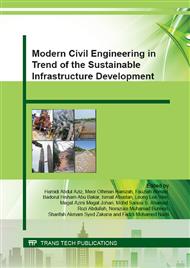p.149
p.155
p.161
p.166
p.172
p.178
p.184
p.190
p.196
Estimation of Tsunami Force for Onshore Buildings in the Northwest Coast of Peninsular Malaysia
Abstract:
The northwest coast of Peninsular Malaysia had suffered various extents of structural damage and loss of 68 lives in the unprecedented 2004 Indian Ocean tsunami. Since then, the government of Malaysia concerns about the safety of civil engineering structures and human lives in coastal area. An experimental study was embarked on the formulation of tsunami force for onshore buildings in Peninsular Malaysia. Four downscaled rigid building models with various heights were subjected to probable tsunamis with three nominal wave heights and flow velocities. The wave pressures at front and back faces of building model were measured. The findings show that the front face wave pressure measured from the experiment is in good agreement with the wave pressure predicted using the equation proposed by Japanese researchers. The back face wave pressure distribution is found to be slightly higher than the hydrostatic pressure. The pressure distributions at the front and back faces were then proposed for the estimation of tsunami force on buildings in the northwest coast of Peninsular Malaysia.
Info:
Periodical:
Pages:
172-177
Citation:
Online since:
October 2015
Keywords:
Price:
Сopyright:
© 2015 Trans Tech Publications Ltd. All Rights Reserved
Share:
Citation:


